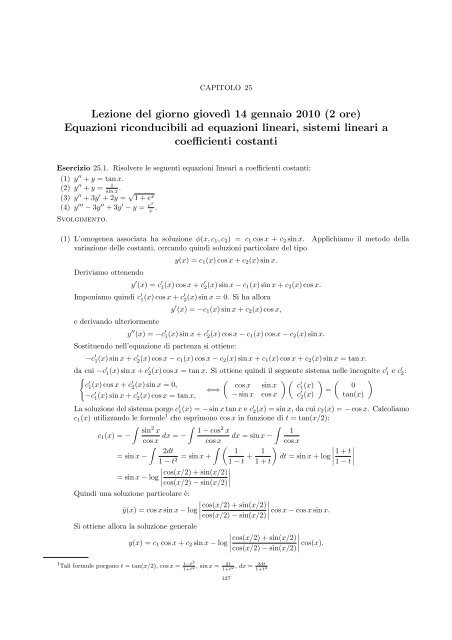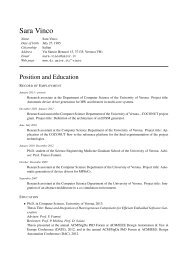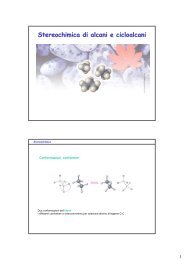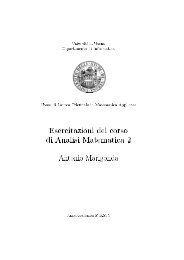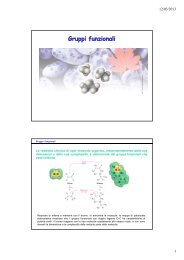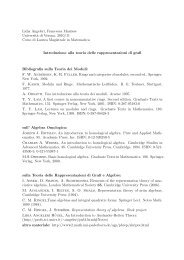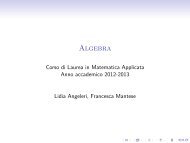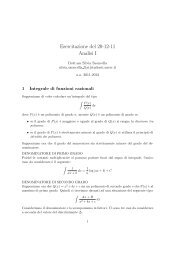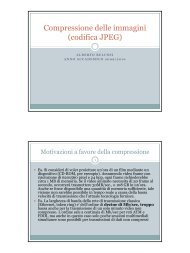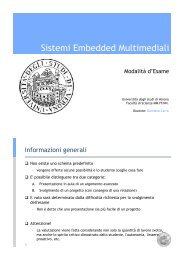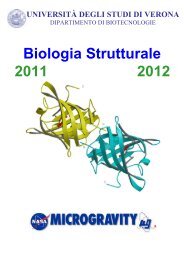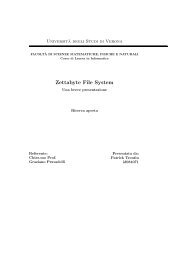Create successful ePaper yourself
Turn your PDF publications into a flip-book with our unique Google optimized e-Paper software.
CAPITOLO 25<br />
Lezione del giorno giovedì 14 gennaio 20<strong>10</strong> (2 ore)<br />
Equazioni riconducibili ad equazioni lineari, sistemi lineari a<br />
coefficienti costanti<br />
Esercizio 25.1. Risolvere le seguenti equazioni lineari a coefficienti costanti:<br />
(1) y ′′ + y = tan x.<br />
(2) y ′′ + y = 1<br />
sin x .<br />
(3) y ′′ + 3y ′ + 2y = √ 1 + e x<br />
(4) y ′′′ − 3y ′′ + 3y ′ − y = ex<br />
x .<br />
Svolgimento.<br />
(1) L’omogenea associata ha soluzione φ(x, c1, c2) = c1 cos x + c2 sin x. Applichiamo il metodo della<br />
variazione delle costanti, cercando quindi soluzioni particolare del tipo<br />
Deriviamo ottenendo<br />
y(x) = c1(x) cos x + c2(x) sin x.<br />
y ′ (x) = c ′ 1(x) cos x + c ′ 2(x) sin x − c1(x) sin x + c2(x) cos x.<br />
Imponiamo quindi c ′ 1(x) cos x + c ′ 2(x) sin x = 0. Si ha allora<br />
e derivando ulteriormente<br />
y ′ (x) = −c1(x) sin x + c2(x) cos x,<br />
y ′′ (x) = −c ′ 1(x) sin x + c ′ 2(x) cos x − c1(x) cos x − c2(x) sin x.<br />
Sost<strong>it</strong>uendo nell’equazione di partenza si ottiene:<br />
−c ′ 1(x) sin x + c ′ 2(x) cos x − c1(x) cos x − c2(x) sin x + c1(x) cos x + c2(x) sin x = tan x.<br />
da cui −c ′ 1(x) sin x + c ′ 2(x) cos x = tan x. Si ottiene quindi il seguente sistema nelle incogn<strong>it</strong>e c ′ 1 e c ′ 2:<br />
<br />
c ′ 1(x) cos x + c ′ 2(x) sin x = 0,<br />
−c ′ 1(x) sin x + c ′ 2(x) cos x = tan x, ⇐⇒<br />
cos x sin x<br />
− sin x cos x<br />
c ′ 1(x)<br />
c ′ 2(x)<br />
<br />
=<br />
0<br />
tan(x)<br />
La soluzione del sistema porge c ′ 1(x) = − sin x tan x e c ′ 2(x) = sin x, da cui c2(x) = − cos x. Calcoliamo<br />
c1(x) utilizzando le formule1 che esprimono cos x in funzione di t = tan(x/2):<br />
2 2 <br />
sin x 1 − cos x<br />
1<br />
c1(x) = − dx = −<br />
dx = sin x −<br />
cos x cos x<br />
cos x<br />
<br />
<br />
<br />
2dt<br />
1 1<br />
<br />
= sin x − = sin x + + dt = sin x + log <br />
1 + t<br />
<br />
1 − t2 1 − t 1 + t<br />
1<br />
− t<br />
<br />
<br />
<br />
= sin x − log <br />
cos(x/2) + sin(x/2) <br />
<br />
cos(x/2)<br />
− sin(x/2) <br />
Quindi una soluzione particolare è:<br />
<br />
<br />
<br />
¯y(x) = cos x sin x − log <br />
cos(x/2) + sin(x/2) <br />
<br />
cos(x/2)<br />
− sin(x/2) cos x − cos x sin x.<br />
Si ottiene allora la soluzione generale<br />
<br />
<br />
<br />
y(x) = c1 cos x + c2 sin x − log <br />
cos(x/2) + sin(x/2) <br />
<br />
cos(x/2)<br />
− sin(x/2) cos(x).<br />
1 Tali formule porgono t = tan(x/2), cos x = 1−t 2<br />
1+t 2 , sin x = 2t<br />
1+t 2 , dx = 2dt<br />
1+t 2<br />
127


